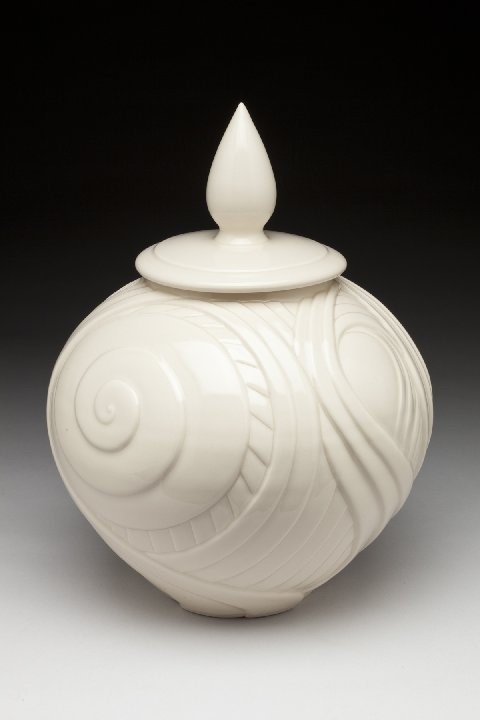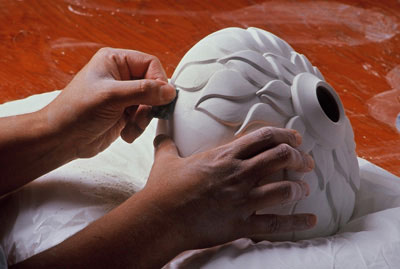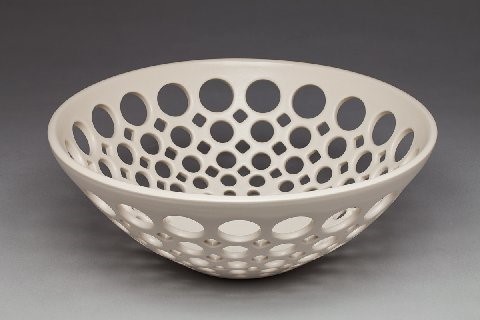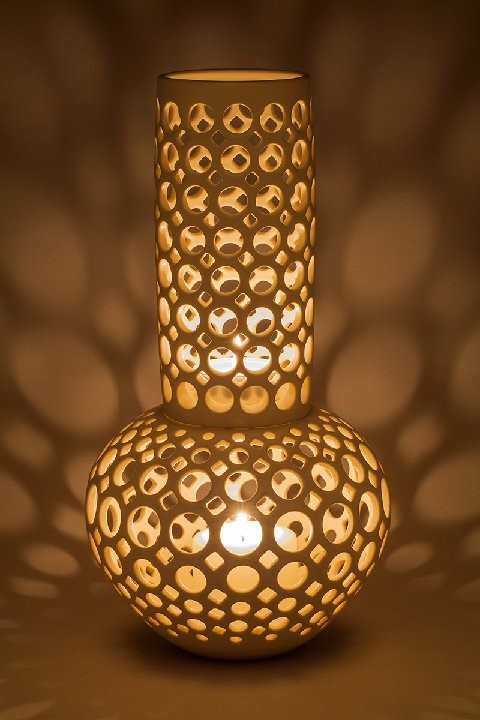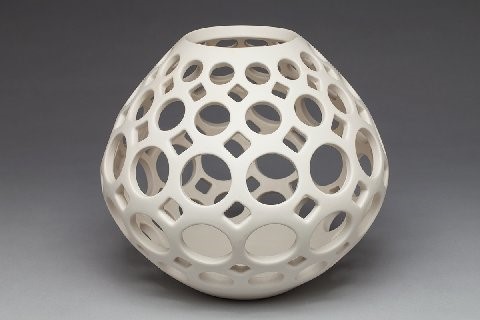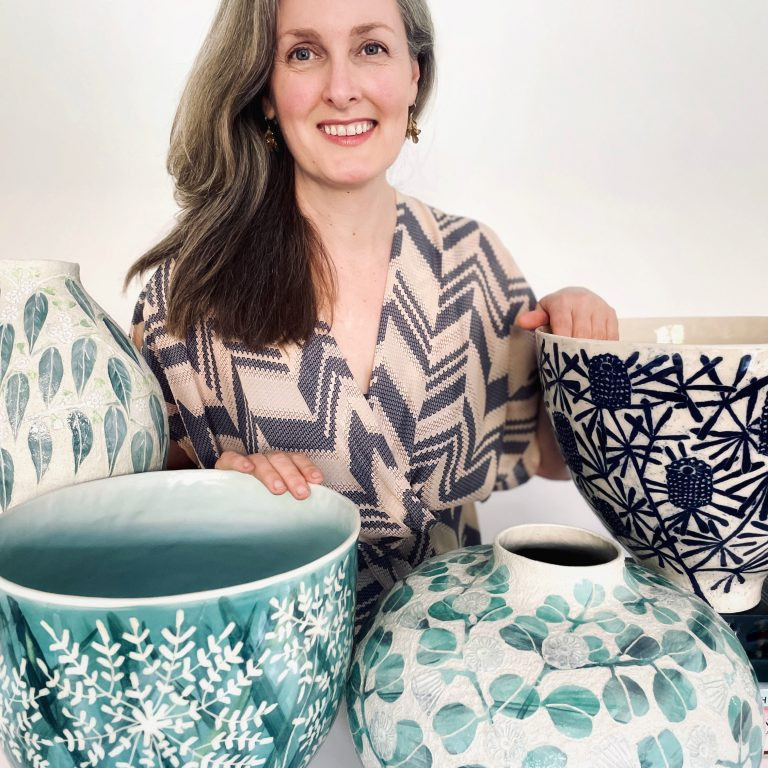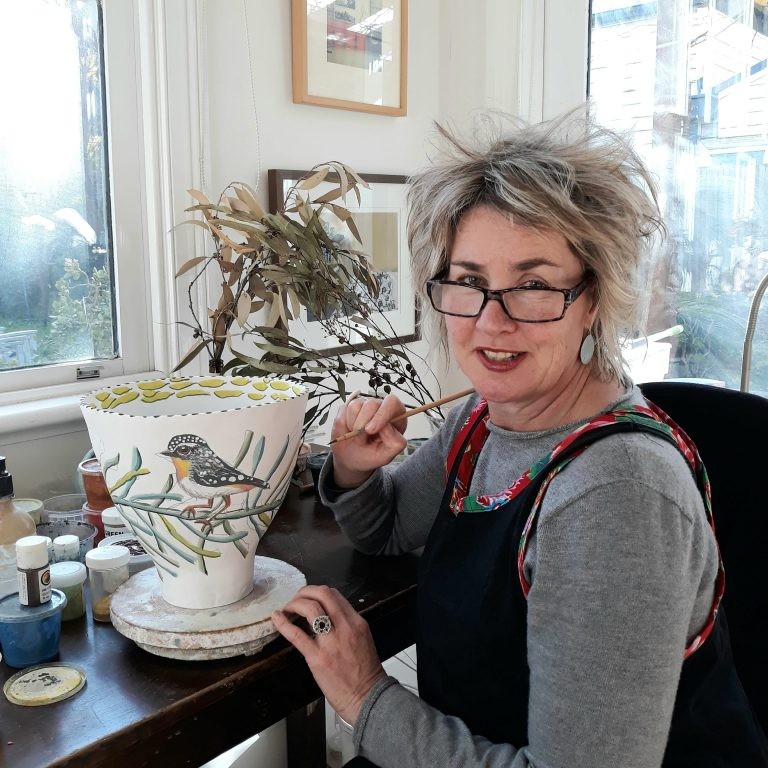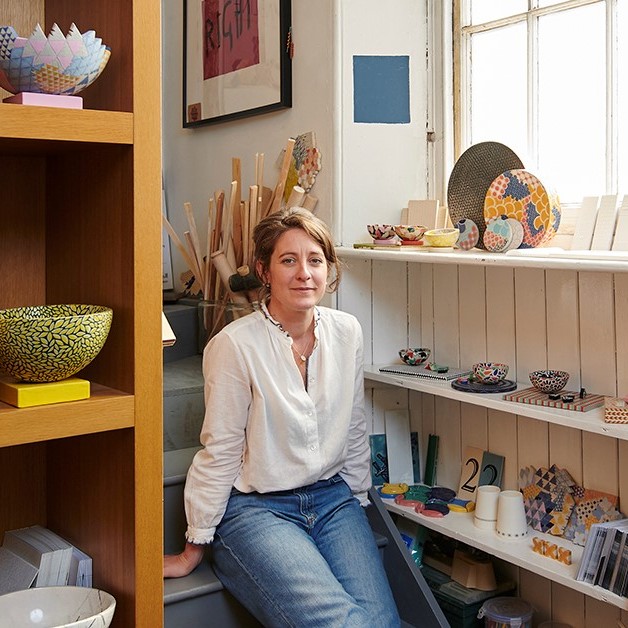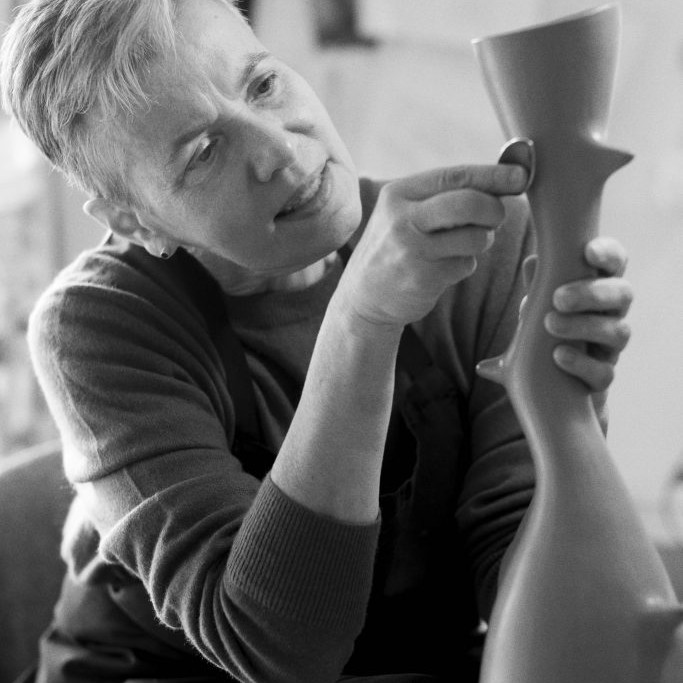Lynne Meade Ceramic Artist - California, USA
Before we discuss all the changes in your work can we take a quick look at the past?
You did your art training majoring in ceramics, when did you first realize that you had a love affair with clay?
I started working as a as an unpaid intern for a potter in my home town the summer before I went to college. I cleaned the studio and gallery in exchange for sitting in on the classes that he taught. When I went off to college, I took a class and knew it was going to be my major and my life’s work and passion.
Can you take one of your older pieces and discuss why it gave you and still gives you such pleasure?
Yes, there is a round form that I titled Perpetual Motion.
‘Perpetual Motion’ 14’’
The lines swirl and flow in such a way that it just seems like a whirlwind of endless movement. I All my pieces have stories or emotions behind them that I generally don’t share with customers. My patterns for the carved pieces usually came from some emotional issue that I was processing. At the time I developed that pattern there was a lot of turmoil in my life. I have said in the past that it was a time when I probably should have been sedated. My mind was always going 90 mph and often around in circles. I love the pattern for its balance and motion, and for its pure visual beauty. I also can look at it now and be reminded that life doesn’t always have to be like that. That if you put your mind to it, you can resolve the turmoil. It also reminds me to be grateful for everyday that is peaceful and happy.
What lead you to make the decision to make a transition in your style?
I got really bored after 17 years of carving. I felt that at least for the moment I had taken that body of work as far as I could take it. At some point I may go back to it, but would want to come back to it refreshed and with a new inspiration or perspective. It would be interesting to combine the carving and the pierced work someday.
How difficult has it been to leave behind styles that you know sell?
Very easy. I make pots because I love to make pots. But what I was doing had become tedious and I no longer loved it.
What new techniques materials have helped you to make your current transition?
I saw a concrete lantern in a neighbor’s yard and thought it would be fun to try to make one in clay. I brought the idea to an advanced ceramics class that I was teaching. The students were enthusiastic so I started collecting images of all kinds of lanterns and sending them to the students and we spent a semester exploring and experimenting. I was really inspired and intruigued to see how far I could take the technique. At first it was about light and porcelain but since then it has spread to tableware and purely decorative pieces. Now for me it is about interior and exterior space and how those spaces are defined and broken.
Bowl 12’’
What new techniques have you had to develop?
The piercing has been a real technical challenge. I have been trying to see just how little clay I can leave before the form self-destructs. I have always worked with symmetry and pattern. It just seems to be how my brain functions. So creating symmetrical patterns has not been challenging, but testing the limitations of the porcelain has been both gratifying and frustrating at times. But that is the fun.
Cylindrical Bowl 8’’
You have several upcoming exhibitions how have you coped with the new work and the production needed also the expectations of the Galleries?
My carved work, with the exception of the tiles, has never sold well in galleries. So for the carved vessels, I have mostly sold them myself. I suspect that this new work , because it includes tableware will be easier to sell in galleries.
Did you discuss the transition of styles with others, if so was it helpful?
Most people were surprised that I would give up the work that had established me as an artist, the work that I had become known for. I knew it was a risk but I also knew I just had to do it. Last weekend was the first time I showed it publicly and I had a feeling that it would be fine. It turns out it was. I thought that steady customers might be put off by the change, but they came and made purchases and were very encouraging. I think people understand that artists need to move forward. In some ways non artists are very excited by an artist changing and evolving. Many said they were impressed at the courage that it took to let go of something that was no longer working for me and jump off a cliff into the unknown. I hope it inspires others to do the same.
Round 10’’
Your former work was one of a kind, am I correct that this will continue to be your approach?
Not really. My old work felt a bit precious to me. I want to make more affordable work. When I was younger I think I was chasing prestige. I’m not necessarily proud of that, but I needed to feel like people were willing to pay a lot for my work in order to make me feel valued as an artist. That wasn’t the whole motivation, it’s more complicated than that, but it was definitely part of the appeal. It was an insecurity. As I have gotten older and more confident in my career now I just want to make things that make me happy or challenge me and I want to send them out into the world to make other people happy.
Pendant Lamp 9’’
How long did you need to make the transition?
I think for me it takes at least a year to develop a whole new body of work. To develop the technique and the aesthetic. I have been at this one for less than a year and I think it will keep evolving for quite a while, but it is at least at the point where I can put it out publicly and be proud of where it is right now. I don’t know where it will be in a year, but I am looking forward to finding out.
Take a new pieces and discuss how it has excited you and why?
My Double Gourd lantern is a favorite.
Double Gourd Lantern
It references a traditional shape that is found in many cultures around the world, but adds something very new and different. It is two stacked pieces. You can put a candle in the bottom and the top, with some precautions, it was also important to me that it was good enough just as a piece of art that it could be shown without candles and still stand up. I also like that it can be used as two separate lanterns or two “vessels” to make a nice composition unstacked. I love its versatility and ability to change according to the owner’s needs or wishes.
How tempting has it been not to fall back to your former style?
Not at all. In fact I have a couple of orders for carved pieces and the thought is not appealing. I will do them because the customers really want them, but my heart is not in it right now.
From the process what valuable lessons have you learnt?
It has been amazing. When you spend 17 years doing one thing you wonder if you can do something else. I wondered if I was only successful because of this one thing. This process has taught me that I am what makes the work. The work is not what makes me. It has given me a confidence that I couldn’t have imagined before this transition. It let me know that when something isn’t working anymore, you can leave it behind. If the first attempt at reinvention doesn’t work, try another. It also gave me very tangible proof that my instincts are good and I should follow them. For me, this journey has been about listening to my own voice and staying true to my own vision. People who expressed doubt and worry were, for the most part, expressing their own fears about their own lives and choices. I have learned not to let those voices over ride what I know to be true in my heart. That is an incredibly valuable lesson that I really needed to learn.
Teardrop 14”
Contact details.
www.lynnemeadeporcelain.com
Lynne Meade, California, USA
Interview by Deborah Blakeley, August, 2015
Think a colleague or friend could benefit from this interview?
Knowledge is one of the biggest assets in any business. So why not forward this on to your friends and colleagues so they too can start taking advantage of the insightful information the artist has given?
Other artists you may be interested in:



